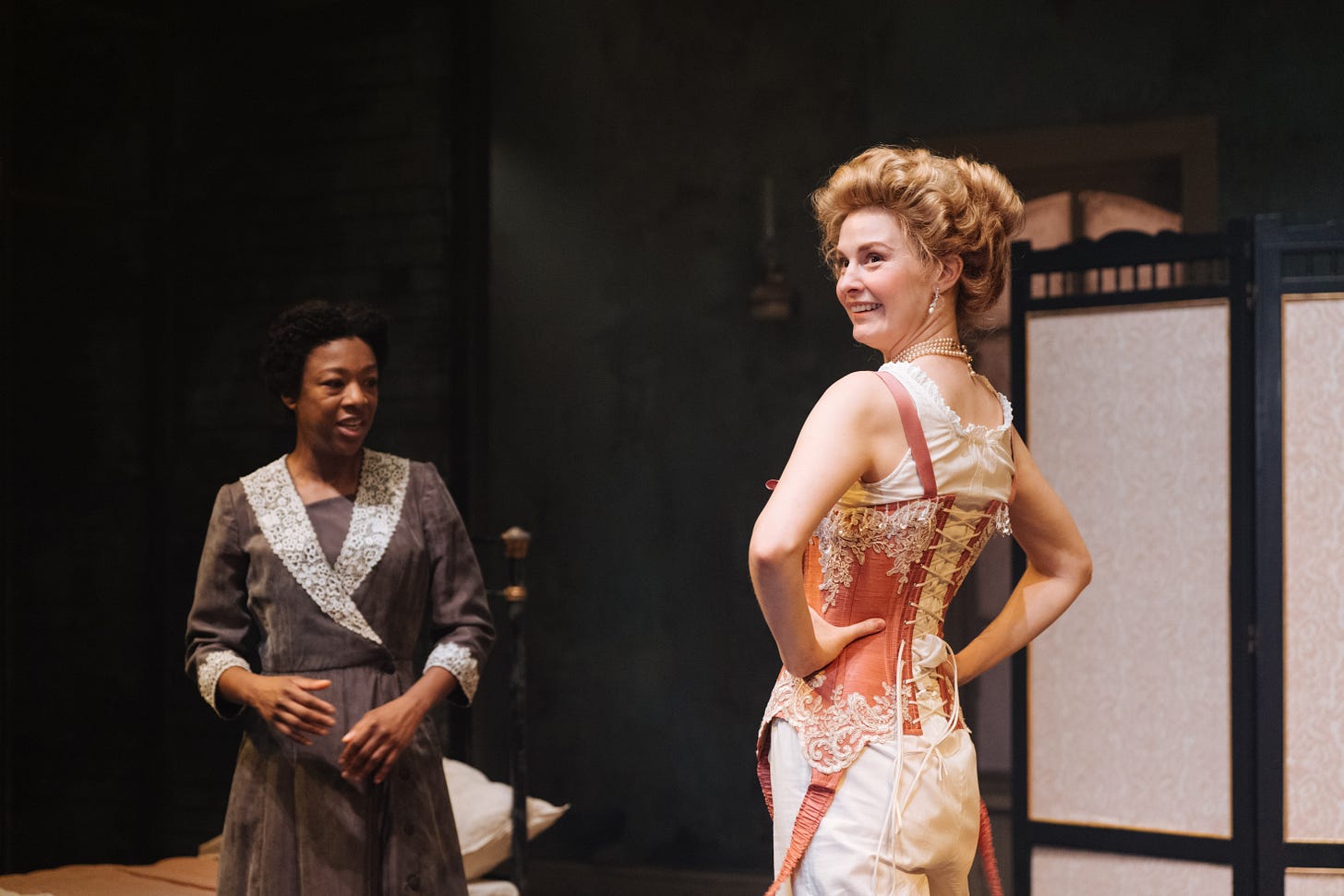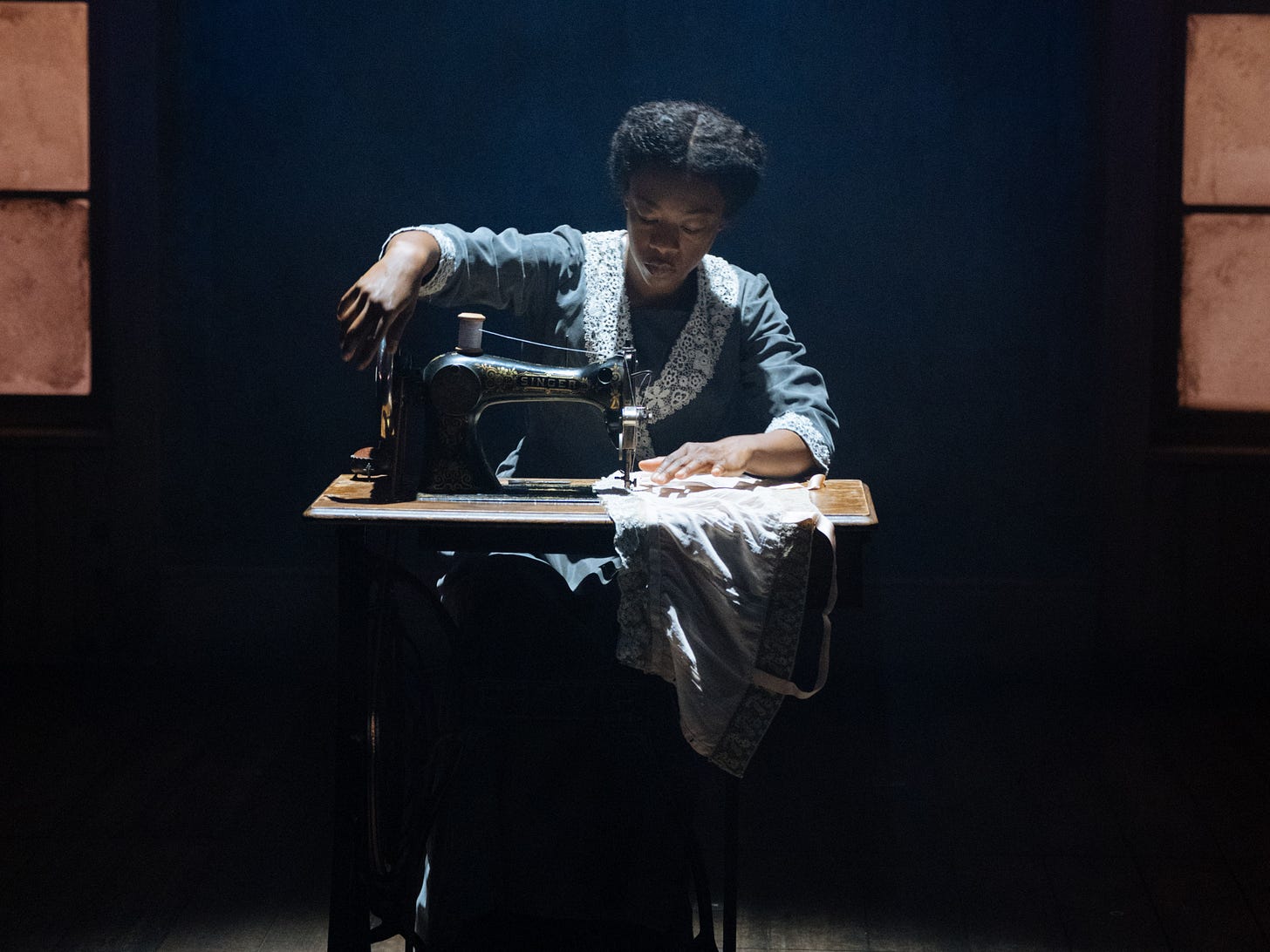Reach out and touch it
Theatre can be a sensual thing - but what role does touch play in an often arm's length art form? Holly Williams explores three tantalising new shows

By Holly Williams
The soft whirr of fine fabric pulled from a bolt. The whisper of a hand, smoothing it flat. Silk, cool to the touch.
The special thing about theatre, people always say, is that it’s happening in the room with you. A collective, communal experience; we’re all sharing the same space, breathing the same air. This is theatre’s magic: the one-off, real-time ‘realness’ of what’s happening in front of us, tantalisingly tangible compared to the replicable, mechanical reproduction of film or record. Actual bodies, in actual space.
And yet it is not – or not all that often – a tactile one, in the simplest sense. We can look, we can listen, but we’re not invited to touch in most traditional theatre (more later on the exceptions to this). And yet even the most arm’s length theatre can still be a deeply sensual thing, appealing to our sense of touch.
Igniting this sense can be purely pleasurable – I’ve often found myself swooning at costumes, imagining how they might feel against the skin. Oh, to run my hands through the ostrich-feathers of a headdress from Follies, or to sneakily swirl into the chorus in High Society and feel tulle foaming around my legs. I was so envious of Anna Chancellor and Toby Stephens spending the second act of Private Lives lounging and loving and fighting in silk pyjamas, I bought some (cheap, satin) versions of my own shortly afterwards.
A textural quality to design can also be tantalising or transformative. Who saw Georgia Lowe’s design for The Good Person of Szechwan and didn’t want to ruffle the pool noodles and dive down a slide into the ball pool, to splash about childishly? Who wasn’t enchanted by the magical world created in Rob Howell’s fuzzy, rough-edged, super-colourful designs for The Lorax, with its fluffy trees and irresistible puppets? And on the subject of puppets… have I ever wanted to cuddle anything more than the gigantic, mountain-sized Totoro in My Neighbour Totoro? I am quite sure I could finally know true peace, true rest, if a stage manager would just smuggle me in for a nap on giant Totoro’s big soft furry belly.
Sometimes, the audience are explicitly invited to touch. I asked other Exeunt writers about such tactile moments, and Ben Kulvichit warmly recalled Kate McIntosh’s In Many Hands, where different objects were passed around the audience, from gold leaf to fossilised poo: a jewel-like performance, he wrote in Exeunt at the time, “concerned with preciousness, value and delicacy, and sort of exquisite.” Although another writer was less impressed, it’s fair to say, by being given a leaf at Mnemonic at the National recently, encouraged feel how its form matched that of a family tree: “v naff”.
I didn’t see either of those, but the touchability of theatre has been on my mind, as I’ve recently enjoyed a run of very different shows that nonetheless all played with this quality. That, in very different ways, cocooned their audience in a plush, sumptuous materiality. That got my fingertips twitching, with a yearning desire to reach out and touch… but that also had quite different impacts on my body, and how I experienced the show. For all their variances, taken together they cracked open a topic I’d not given much thought to before – so this is a thinking-out-loud about how theatre makers can appeal to this sense of touch, directly or evocatively, and how a sensual experience of a show might affect our understanding of it.
A blue so deep it seems to hum. Shaken out, it floats and spreads and settles. Like dusk darkening a sky.
Lynn Nottage’s 2003 play, Intimate Apparel, is all about touch. Esther, a black seamstress in New York in 1905, has fine fingers. She works hard, but she also has a real way with silk: she crafts exquisite lingerie and negligee for rich white women to sport in private and for poor black women to wear on the job. (And don’t even those words – lingerie, negligee – have their own tactility? Surely we cling to the French for how fine and filigreed it looks and sounds, compared to, say, knickers.)
Esther is alive to all the sensual possibilities of fabric. In Lynette Linton’s current production at the Donmar Warehouse, she’s played with a bewitching blend of tender timidity and shining hope by Samira Wiley. And her fingertips don’t just twitch when she sees beautiful lace or silk or wool – it’s like they’re drawn to fine material by some magnetic current. She just has to touch. She’s yearns to make pretty things from fabric (crafted here by designer Alex Berry), for her adoring clients. But, as a still-single woman in her 30s, Esther also yearns to have her own reason to make pretty things for herself, to finally get to wear lace and silk against her own skin. A reason like a wedding. A wedding night. A loving husband, who wants to undress, to reveal, to touch.
There’s also an additional charge in the room, another current of energy: the feeling between Esther and the one other person whose eyes widen and whose hands flutter in the same way when they see a good bit of embroidery or a nice weave… Mr Marks, who owns the fabric store she buys materials from. He’s always saving her a specially enticing offcut. Laying them out for her. Caressing Scottish wool. Fingers moving across lace like its braille, like it might be readable.
In Alex Waldmann’s lovely performance, Mr Marks’ eagerness helplessly unravels in Esther’s presence. And their shared entrancement – with the sheer gorgeousness of fine fabrics, with their unspoken feelings for each other – is infectious. I feel like Intimate Apparel is the only play I’ve seen where the audience gasp, a little, at a piece of material, unfurled.
I don’t get to touch. But watching this play, I can almost feel it. And like the characters on stage, I yearn for touch. I feel their yearning.
A bodice of fringing so fine and so dense it’s like an animal’s rippling fur. Shimmering with every shimmy. Catching the light, like it’s an electric charge.
That statement about not hearing audiences gasping at cloth did feel true when I saw Intimate Apparel. But the following week, I saw Diamonds and Dust, where there was plenty of gasping, cooing, applauding, general appreciation of sensual fabrics – but even more so, of what they were drawn back to reveal. Smooth perfect flesh, smooth perfect bodies.
Diamonds and Dust is big glitzy burlesque show, starring Dita von Teese, at the jewel-box like Emerald Theatre in London. It’s billed as a theatre show, narrative burlesque created Tosca Rivola, but the story – delivered by Faye Tozer, a Wild West gal who ran her own gambling saloon – has about as much substance as a fishnet stocking / glittery thong / insert other scanty item of intimate apparel here. Any gasping is definitely not because the audience is invested in a character’s inner life, for they have none. As a show, it’s all surface – and that surface is quite literally dazzling: the friend I took grabbed my arm at one point and started muttering that Dita von Teese’s rhinestone leotard was the shiniest thing she’d ever seen. And there was an encrusted density to the gems and glitter that made my fingernails itch, this time with the urge to pick at it, like a satisfyingly glittery scab.
This show is deliberately, intentionally sensual – made for the eye to feast on, and to fire up the imagination beneath. Much of burlesque is about the tease, of course, the conceal and the reveal – but they’re never teasing you by hiding behind hessian sackcloth. In Jenny Packham’s couture costumes, there’s glamour to every single part of every single outfit that eventually gets flung off, from fringing that flickers flirtily with each step to sheer dressing-gowns with marabous trims that waft like a cloud of scent to corsets pulling waists into hourglasses of glassy silk and satin.
It all leads towards nudity: bare skin, as the final layer. The most intimate thing you can touch. And yet, the bodies revealed beneath all the trimmings are dazzling, too – if, that is, you find yourself dazzled by gravity-defying pertness, improbably large in certain places and improbably small in others. Which a lifetime of living under Western beauty standards and patriarchy has trained many of us to be dazzled by… A full dissection of this bizarrely retro take on an already-retro art form – so very straight; such a narrow boring standard of beauty – is probably beyond the scope of this piece. But I include Diamonds and Dust not only because it did, very deliberately, in a way few theatre shows do, set out to seduce us with a sense of what these things on stage might feel like… but also because I found it ultimately oddly un-seductive.
I think it’s because it’s all so perfect, and so clean. No rough edges. None of the mess or muckiness or unpredictability or chaos or terror of actual sexiness. Which, to be fair, is not what it’s aiming for: it is selling a fantasy, a safe, sanitised, hyper-stylised performance of female sexuality, neatly tied up with a bow and served with a knowing wink. So yes, it dazzled; but it did not make me yearn, like a roll of silk and a tentative glance and a hovering hand in Intimate Apparel made me yearn.
I wonder if there a question of identification here: when I watch Intimate Apparel, I can’t help but put myself in the character’s shoes, feeling what they feel, recognising that hunger for touch, for recognition, for understanding, for love. When I watch Diamonds and Dust – even though it is a show made by women, largely for an audience of women – I feel like I’ve put straight-man goggles on. I am the bloody male gaze. The performers are objects to be admired, not characters to feel with. And, as much as I really would love to feel the tickle of a marabou-trimmed gown down my naked back, as I watch, I don’t find myself in that identifying role – the niggle of ‘well you’d look shit in that’ always intrudes. I am forced, by my own, very normal, entirely non-dazzling body, to stay as leery spectator, gazing on unreachable, untouchable perfection. I know I could not wear its clothes. The pleasure remains coolly visual, not warm to the touch.
I watch. I don’t touch. I’m not moved. I’m not even yearning.
Fluffy swags of soft wool surround and coddle, spiralling upwards. Softening, glowing, mushrooming.
When I came out of another show in the same week, I turned to a different friend and we immediately gabbled the same thing at each other: The cocoons! The wool! I want to live inside this show… I want to curl up, to nestle, to burrow into it. To maybe stay after the play is over and maybe take mushrooms and maybe become one with the set itself… (I am the mycelial gaze.)
Storehouse is a new immersive show that seems to have absolutely nothing in common with Intimate Apparel or Diamonds and Dust: forget intimacy and undergarments, this is world-building on the grandest scale, with a convoluted story about disinformation weaving through an absolutely gigantic transformed warehouse. Small groups are taken inside an organic kind of library, which every piece of data ever shared on the internet is fed into, but the word ‘organic’ is key: this is no sterile server or industrial factory. Designer Alice Helps did in fact draw on the idea of mycelial networks, to create a space that feels like it might just be alive. There are rooms like upturned birds’ nests of woven willow branches, but best are the woolly pods, which feel like being in a cloud. Or a particularly cosy igloo. Or maybe a sheep’s idea of heaven.
I include it because when thinking about bodies in space in theatre, it’s fair to say that this space had an immediate bodily effect on me: calming, soothing, swaddling. (Me and Totoro could have a REALLY great nap here.) And that physical impact was surely much more all-encompassing than if this was just a set, gazed at on a distance stage. Its closeness was part of its impact. But there was yet more yearning too, I’m afraid: because for all Storehouse activated my desire to feel, it also thwarted it. Although we play with plenty of other props, there are signs that tell us not to touch those fluffy walls. Understandable; thousands of people need to come through, and it’s presumably too delicate for us all to pet and pat.
But immersive theatre is, of course, one of the exceptions to my ‘no touch, arm length’ generalisation about theatre. The other, which I’m not going to go much into because I have too little experience, is sensory theatre – work made for people who are neurodivergent or have learning disabilities or for young children (see instead two excellent recent pieces: Lyn Gardner on companies like Oily Cart, Frozen Light and Flute Theatre, or Alice Saville on baby theatre). But within more mainstream and commercial theatre, it is often immersive work that takes the leap to become a multi-sensory affair.
It’s expected that you might be interacting with the environment, wrangling props, or touched by actors. Sometimes, this touch can be challenging or actively unpleasant (see Emily Jupp’s memories of being “tortured” in one immersive show), but it’s often more gentle. I’ve been tenderly tucked up in bed, passed freshly-baked bread to break, or been taken by the hands and danced with. I know of people who’ve had deeply meaningful – and also, yes, distinctly uncomfortable – physical experiences in immersive theatre; as the art form develops, I feel like makers have become more careful around consent and physical interaction (for their own sakes as much as the sakes of shy audience members).
So interacting with the space – the world of the show – is a safer and more common avenue for touch-based immersion. But it’s also one that still feels like it’s being pushed further, rather than reined in. I’ve not seen You Me Bum Bum Train, but I understand that some of the tasks in that are pretty damn active and embodied. And I did see the latest, small-scale Punchdrunk show, Viola’s Room, which not only created a whole enveloping world – part fairytale, part 90s teenage girl’s bedroom – but also asked you to actively push through its dreamy spaces, down tight corridors of spongy walls of fabric, bare feet landing gingerly on different surfaces. I did feel truly immersed in it – covered, surrounded, not just touching the world of the show but wholly within it. It was a full-body experience in a way few plays are.
It’s also fair to say that in a lot of immersive shows, this built environment seems to take precedent over the story, something that comes up time and again in reviews and commentary of the art form. I mean, it’s a yawningly old complaint by now that Punchdrunk’s shows don’t have enough narrative, but maybe it’s interesting that even in something like Storehouse – which goes in the opposite direction with, if anything, an attempt to convey too much story – the thing that entrances is still the constructed world rather than the plot or characters.
I do not touch the walls, but I do feel held. But I yearn to get closer to the world – not its characters.
Spread out a piece of Chinese silk, seaweed green and burned gold. Trace the threads that run through it. That weave and pattern and dance, that tie it all together.
To be clear: immersive shows privileging place and space is not necessarily a bad thing. Different work can do different things – story and character don’t always need to come first! But, in order to attempt to tie these different threads together, to stitch my own argument towards some manner of conclusion… let’s return to story, and character, and how they might intersect with touch, and non-touch, with wanting, and not having.
I was struck, watching Intimate Apparel, by just how seamlessly Nottage both crafts a show that is deeply sensual in its own right and which makes the very concept of touch a thematic thread that runs throughout the play, through every character and every part of its narrative. (Side note: isn’t it interesting, how much of our language for describing drama pulls on sewing and crafting imagery? Lots of the reviews for Intimate Apparel are gorgeous in their own right and, as I’ve been indulging in too, many of them really play with the language of making).
Nottage is herself a fine craftsman. She knows all about beautiful construction. So in all those scenes where the audience yearn to touch, to experience the sheer physical pleasure we see Esther and Mr Marks take in their fabrics, Nottage ensures those characters are also yearning for what they cannot touch: that is, each other. Mr Marks is a Hasidic Jew; he is not allowed to touch anyone who is not his wife. And Esther can never be his wife.
Silk isn’t drawn back to reveal skin: silk becomes a proxy for skin.
And because Nottage really knows how to make a well-made play, this theme of thwarted touch – of hungering for what you’re not allowed – is the thread that runs right through the play, that she attaches to all her characters, so that she might lace them together tightly and neatly. So just as Ether may long for a man’s touch, one of the rich women she makes corsets for longs to touch Esther. Of course, the layers of attraction, denial, secrecy, repression, and entitlement play out differently between the rich white woman and the poor black woman. And they also play out differently between Esther and her friend, a sex worker who is continually navigating an abundance of touch, but not the sort she wants – until she finds it in a married man, who’ll prove forbidden in yet another, different way.
Swish. A silk dressing gown, drawn and closed across the body, across the skin.
So yes: literal, physical touch – an embodied experience – can be used to give us a fuller, more all-encompassing sense of the world of a play in an immersive show. But for most theatre, a sense of touch remains at a distance. The tangible onstage remains intangible for us watching. The feeling can be conjured in our bodies, but is not enacted.
And maybe, it is exactly the fact that we don’t get to touch what’s onstage that sometimes gives it such power - helping amplify our investment, our emotion, sat at a remove in the audience. Maybe we need something to yearn for. And when our desire to touch something beyond our reach is mirrored in the characters’ own pained desires, to have what they cannot have, to touch who they may not touch… well, that mirror actually becomes a door, letting us in. We’re all in the room, together: reaching, but not touching.
Intimate Apparel is at the Donmar Warehouse to 9 August. Diamonds and Dust is at the Emerald Theatre to 28 September. Storehouse is at Storehouse Deptford to 20 September. My Neighbour Totoro is at the Gillian Lynne Theatre until March 2026.













